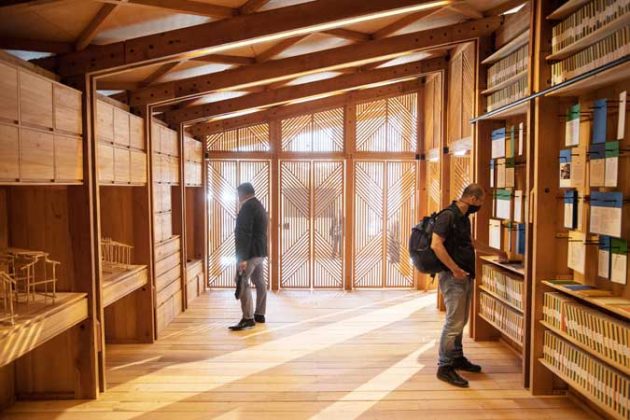THE QUESTION some people may ask is “How did a Philippine library become this year’s pavilion at the Venice Architecture Biennale?”
Well, the story starts in late 2019 when architects Sudarshan Khadka, Jr. and Alexander Eriksson Furunes conducted a 22-day workshop in Barangay Encanto in Angat, Bulacan with 32 representatives the GK Enchanted Farm community, composed of farmers, carpenters, housewives, students and other laborers, to attend the workshop. The representatives also invited the members of the community of Barangay Encanto in the workshop and they all discussed building a structure within and for the community. They decided to build a library.
“We started by reflecting on what are the problems and what are the possible solutions of the community. At first there are many opinions and different stories. But as we [went] further with the collaboration, we saw one thing from every opinion, and we came up with a library and it is [was] very fun and fulfilling journey for everyone,” said Aliza Mae Antonia, a community representative of GK Enchanted Farm said of the experience in a documentary video.
“The power of the collective is greater than individuals alone. There is this natural synergy which happens when people come together and create something none of them can do on their own,” Mr. Khadka said in the same video.
The building meant to cater to a specific community was built — then dismantled and shipped across the world where it would serve as an example of the bayanihan spirit.
THE VENICE BIENNALE
Due to the COVID-19 pandemic, the 17th Venice Architecture Biennale was postponed twice. Originally scheduled to open in May 2020, it was moved to July, postponed again, then finally opened on May 22, 2021.
Meanwhile, the library in Bulacan was dismantled, packed, and shipped to Venice, Italy on March 6 this year, arriving on April 13, then installed in the Philippines’ pavilion alongside other national pavilions at the Arsenale.
The Philippines opened the country’s National Pavilion on May 20, 2021 with an exhibition titled, “Structures of Mutual Support,” curated by Messrs. Khadka and Furunes, and the members of GK Enchanted Farm.
The Philippine’s participation in Venice is a project of the National Commission for Culture and the Arts (NCCA), the Department of Foreign Affairs (DFA), and the Office of Deputy Speaker and Congresswoman Loren Legarda.
“When I spearheaded our participation in the Venice Biennale way back in 2014, my goal was for the country to be involved in the global discourse — a conversation wherein we are able to share concepts and ideas that could make a better future for the world,” Ms. Legarda said in her speech at the exhibit opening on May 20, which was held via Zoom and streamed through Facebook.
“We join the 17th Venice Architecture Biennale with our exhibition Structures of Mutual Support that reminds the world of what truly is essential, our sense of belonging and our being part of humanity. We are telling the world, it is time to forge and frame a new and more cohesive ‘spatial contract,’ which is attentive and empathic and very much responds to the question on how we all can live together,” Ms. Legarda said.
BUILT THROUGH CONCEPTS OF BAYANIHAN AND MAALIWALAS
“Structures of Mutual Support” involves the traditional concept of bayanihan — the spirit of communal unity, work and cooperation to achieve a particular goal, traditionally seen in the moving of a house from one village to the other — as the library structure was transported to Venice for the duration of the exhibit which runs until Nov. 21. It is expected to be returned to the community in Bulacan after.
During a tour of the exhibit livestreamed through Zoom from Venice, Messrs. Furunes and Khadka noted that the structure’s design was built on the concept of “maaliwalas” or being bright and spacious.
“[It is] when space is very bright, airy, it has a lot of air movement. And at the same time, it is also very clean and neat and open,” Mr. Khadka said of the library’s interior during the live tour.
The library’s interior includes shelves, study spaces, storage spaces, and a sitting area.
“Buildings are not just buildings; they are a process. The structure and the way it was created — all that needs to be flexible enough to transform, and live with the community,” Mr. Furunes said.
“It belongs to them.”
The Philippine Pavilion will be accessible to the public through digital programs and virtual tours. To learn about the digital agenda and offerings, visit philartsvenicebiennale.org. Updates are made on Facebook and Instagram via @philartsvenice. To watch video documentaries on the exhibition, go to: PAVB YouTube (https://www.youtube.com/channel/UCiBD6kLhhM4Lpgkh_q04rwA). For more information, on the 17th Venice Architecture Biennale, visit https://www.labiennale.org/en/architecture/2021. — Michelle Anne P. Soliman

